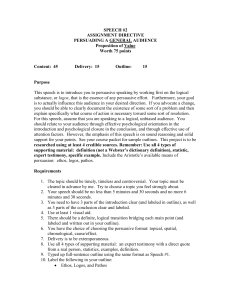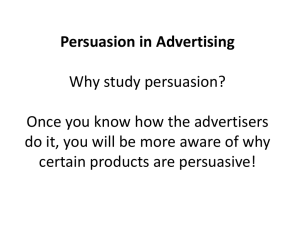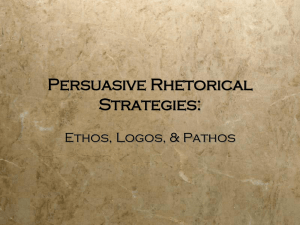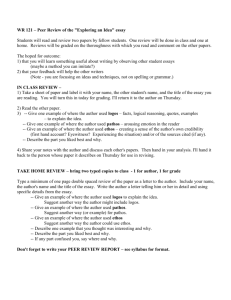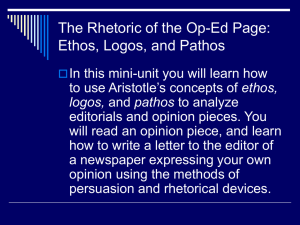What I Learned.doc - Nicholas
advertisement
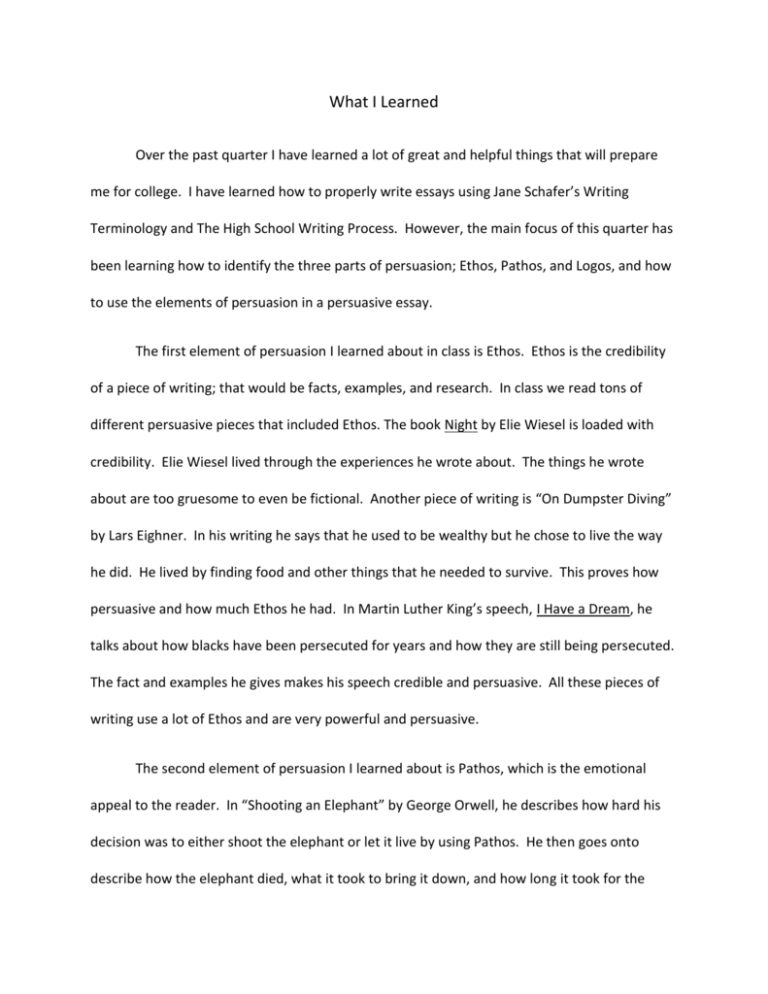
What I Learned Over the past quarter I have learned a lot of great and helpful things that will prepare me for college. I have learned how to properly write essays using Jane Schafer’s Writing Terminology and The High School Writing Process. However, the main focus of this quarter has been learning how to identify the three parts of persuasion; Ethos, Pathos, and Logos, and how to use the elements of persuasion in a persuasive essay. The first element of persuasion I learned about in class is Ethos. Ethos is the credibility of a piece of writing; that would be facts, examples, and research. In class we read tons of different persuasive pieces that included Ethos. The book Night by Elie Wiesel is loaded with credibility. Elie Wiesel lived through the experiences he wrote about. The things he wrote about are too gruesome to even be fictional. Another piece of writing is “On Dumpster Diving” by Lars Eighner. In his writing he says that he used to be wealthy but he chose to live the way he did. He lived by finding food and other things that he needed to survive. This proves how persuasive and how much Ethos he had. In Martin Luther King’s speech, I Have a Dream, he talks about how blacks have been persecuted for years and how they are still being persecuted. The fact and examples he gives makes his speech credible and persuasive. All these pieces of writing use a lot of Ethos and are very powerful and persuasive. The second element of persuasion I learned about is Pathos, which is the emotional appeal to the reader. In “Shooting an Elephant” by George Orwell, he describes how hard his decision was to either shoot the elephant or let it live by using Pathos. He then goes onto describe how the elephant died, what it took to bring it down, and how long it took for the elephant to die. When Martin Luther King gave I Have a Dream, he gave it to raise the emotions of the civil rights supporters. Over forty years later, it is still studied and read and still raises the emotions of its readers. Dr. King says for too long they have been persecuted. He states what he “dreams” to happen in the future. Elie Wiesel uses Pathos in Night as well. He describes the horrible train ride he took to Auschwitz, which makes a pit of sympathy and shock form in a tight ball in your stomach. He describes how the Gestapo would throw the babies in the air and use them as target practice. Reading his description would make you queasy and sick. When Pathos is used in writing it is very effective in influencing people’s emotions. The third element of persuasion is Logos. As Pathos, uses the emotional appeal, Logos is the Logical appeal. In George Orwell’s “Shooting an Elephant,” Orwell uses Logos by explaining why he had to shoot the elephant. He had to shoot it because it had killed a civilian and he would have been mocked and hated if he didn’t kill the elephant like the people wanted. In Lars Eighner’s “On Dumpster Diving” he uses Logos in describing why it’s ok to dumpster dive by showing that people throw out perfectly good things. He also describes what is good to eat and what is not. “Eating from dumpsters is what separates the dilettanti from the professionals.” In Abraham Lincoln’s Gettysburg Address he uses Logos to describe how all men are created equal. He describes how our country is in a great turmoil and that too many people died for it so we need to remember what happened and why. Logos used in these pieces of writing is very effective and very persuasive. Each element of persuasion is a very powerful tool. However, all three together is what makes the writing convincing and will almost always convince the reader the way the author wants. I have learned so much about Ethos, Pathos, and Logos that it makes it easy to identify them and use them. In fact I am able to identify Ethos, Pathos, and Logos in movies and readings outside of class without my teacher pointing them out. I have learned so much and can’t wait to see what is in store for next quarter.
